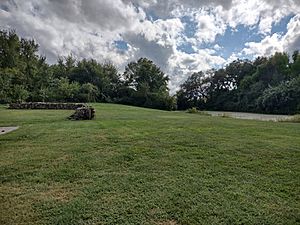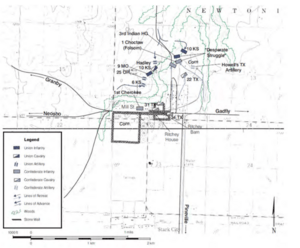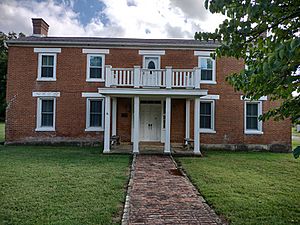First Battle of Newtonia facts for kids
Quick facts for kids First Battle of Newtonia |
|||||||
|---|---|---|---|---|---|---|---|
| Part of the Trans-Mississippi Theater of the American Civil War |
|||||||
 Stone wall near the Ritchey House. Fighting happened close to this area during the battle. |
|||||||
|
|||||||
| Belligerents | |||||||
| Commanders and leaders | |||||||
| Frederick Salomon | Douglas H. Cooper Joseph O. Shelby |
||||||
| Units involved | |||||||
| Salomon's brigade | Indian brigade Shelby's Iron Brigade |
||||||
| Strength | |||||||
| c. 4,000 to c. 4,500 | c. 5,500 | ||||||
| Casualties and losses | |||||||
| 245 or over 400 | 78 | ||||||
The First Battle of Newtonia was a fight during the American Civil War. It happened on September 30, 1862, near Newtonia, Missouri. The battle was between Confederate soldiers led by Colonel Douglas H. Cooper and Union troops led by Brigadier General Frederick Salomon.
Colonel Cooper's Confederate force had moved into southwestern Missouri. They set up camp near Newtonia. His group included mostly cavalry led by Colonel Joseph O. Shelby and a brigade of Native American soldiers.
A Union force, commanded by Brigadier General James G. Blunt, moved to stop Cooper. Blunt's lead group, led by Salomon, reached Newtonia on September 29. They attacked Cooper's position the next day. A Union scouting group, led by Colonel Edward Lynde, was pushed out of Newtonia by Cooper's soldiers on the morning of September 30.
Both sides brought in more soldiers. The battle went back and forth for most of the afternoon. Just before dark, Cooper's Confederates launched a big attack against the Union line. This made Salomon pull his troops back. Militia led by Colonel George Hall helped cover the Union retreat. However, Confederate cannons fired on the retreating soldiers. This caused some of Salomon's men to panic, and their retreat turned into a messy run.
Union forces lost between 245 and over 400 soldiers. Confederate forces lost 78 soldiers. Blunt's entire Union division started moving towards Newtonia in early October. This made Cooper leave Missouri. Part of the battlefield was later named a historic place in 2004.
Contents
Why the Battle Happened
In the early 1800s, the United States grew, but a big difference developed between the northern and southern states. This difference was mainly about slavery. By 1860, slavery was a key part of southern culture. Many southerners used the idea of states' rights to defend it.
Eventually, many southerners felt that leaving the Union was the only way to keep slavery. This feeling grew stronger after Abraham Lincoln was elected president in 1860. Lincoln won mostly in the northern states. He did not get any electoral votes from the Deep South. Many southerners did not accept Lincoln's election. They pushed for their states to leave the Union.
On December 20, South Carolina left the Union. Other states like Mississippi, Florida, Alabama, Georgia, Louisiana, and Texas followed in early 1861. On February 4, these states formed the Confederate States of America. Jefferson Davis became their president.
The war officially began on April 12, 1861. Confederate forces fired on Fort Sumter in South Carolina. The fort surrendered the next day. After this, Lincoln asked for 75,000 volunteers for the war. Soon, Virginia, North Carolina, Tennessee, and Arkansas joined the Confederacy.
Meanwhile, the state of Missouri was deeply divided. The state's governor, Claiborne Fox Jackson, and the Missouri State Guard supported the Confederacy. But Union Brigadier General Nathaniel Lyon supported the Union. Lyon pushed Jackson and the Missouri State Guard into southwestern Missouri. There, they joined Confederate forces.
In August 1861, Lyon attacked the combined Confederate camp at the Battle of Wilson's Creek. Lyon was killed, and his army lost. The Confederates then moved north in Missouri. But Union forces pushed them back into southwestern Missouri. In early 1862, Union General Samuel Ryan Curtis advanced, making the Confederates leave Missouri and go into Arkansas. In March, the Confederates attacked Curtis at the Battle of Pea Ridge but were defeated. After this, the Union felt they had control of Missouri.
Getting Ready for Battle
The peace in Missouri did not last long. Confederate troops returned to Missouri to get supplies and find new soldiers. The state also faced attacks from Confederate groups and guerrilla fighters. These groups caused problems for the Union.
During this time, Confederate Colonel Douglas H. Cooper led his troops into southwestern Missouri. Cooper's force included cavalry from Colonel Joseph O. Shelby's Iron Brigade. It also had a brigade of Native Americans who supported the Confederacy.
A Union force, led by Brigadier General James G. Blunt, started moving south to meet the Confederates. Brigadier General Frederick Salomon led the first part of Blunt's force. Cooper sent a scouting group to Newtonia on September 27. This group found that Newtonia was a good place for communication. They also started using a grist mill to make flour.
Cooper ordered his troops to stay in Newtonia. He sent more soldiers and cannons to them. On September 28, local people told the Confederates that Union troops were coming. But Confederate scouts found no sign of them. Meanwhile, Union forces gathered in southwestern Missouri. Two Union brigades met at Sarcoxie, a town not far from Newtonia.
Who Fought
Union Forces
The Union army at Newtonia had infantry (foot soldiers), cavalry (soldiers on horseback), and artillery (cannons).
- Cavalry: The 6th and 9th Kansas, 2nd Ohio, and 3rd Wisconsin Cavalry Regiments.
- Infantry: The 10th and 13th Kansas, and 9th Wisconsin Infantry Regiments.
- Artillery: The 1st and 2nd Kansas Light Artillery Batteries, and the 25th Ohio Battery. They had five cannons, including two mountain howitzers.
- Also present was the 3rd Indian Home Guard.
Historians say the Union force had about 4,000 to 4,500 soldiers.
Confederate Forces
The Confederate forces at Newtonia included:
- The 1st Cherokee Battalion
- The 1st Choctaw Regiment
- The 1st Choctaw and Chickasaw Mounted Rifles
- Colonel A. M. Alexander's 34th Texas Cavalry Regiment
- Lieutenant Colonel Beal G. Jeans' Missouri Cavalry Regiment
- Hawpe's 31st Texas Cavalry Regiment
- The 5th Missouri Cavalry Regiment
- Colonel James G. Stevens' 22nd Texas Cavalry Regiment
- Bledsoe's Battery and Captain Sylvanus Howell's Texas Battery (cannon units).
Historians estimate the Confederate strength was around 5,500 soldiers. Some estimates go as high as 7,000.
The Battle Begins
First Actions
On September 29, Union General Salomon sent out three scouting groups. One went to Neosho, one to Granby, and one to Newtonia. The group sent to Newtonia had 150 men from the 9th Kansas Cavalry. They also had two mountain howitzers (small cannons).
These Union soldiers pushed back Confederate scouts towards Newtonia. They found that a strong enemy force was in the town. The Confederate commander in Newtonia, Hawpe, told Cooper about the Union probe. Cooper sent more regiments to Newtonia.
When the Union group reached Newtonia, they saw it was held by Confederates. Their small cannons couldn't reach the town, so they pulled back. They captured two Confederate soldiers who told them Newtonia was strongly defended. Cooper and Shelby's regiments arrived in Newtonia after the Union retreat. The Union force was not chased.
Salomon heard the sounds of fighting from Newtonia. He sent two companies of the 9th Wisconsin Infantry to help.
Fighting on September 30
More Union soldiers arrived near Newtonia around 7:00 AM on September 30. This group included men from the 9th Wisconsin Infantry, 6th Kansas Cavalry, 3rd Indian Home Guard, and three cannons. They tried to surprise the Confederates but failed.
After some hard fighting, the Union group was joined by Lynde's scouting force, who had returned. The Confederates, including the 31st Texas Cavalry, 1st Cherokee Battalion, and Bledsoe's artillery, took defensive positions near Mathew H. Ritchey's farm. An artillery duel (cannon fight) began. The Union cannons moved closer, making their shots more effective.
Some Union infantry moved to the houses on the edge of Newtonia. They started sniping at the Confederate cannon crews. Cooper heard the battle and sent the 34th Texas Cavalry to help.
The 31st Texas Cavalry, who were hiding behind a stone wall, charged the Union line. But Union cannons fired canister shot (a type of shotgun blast for cannons), quickly pushing them back. The Union artillery then focused on Bledsoe's battery. The Confederate cannons ran low on ammunition after about 30 minutes. When the Union commanders saw the Confederate fire slow down, the 9th Wisconsin Infantry charged.
Bledsoe moved his cannons back a bit. At this time, more Confederate soldiers arrived. These fresh units, including the 1st Choctaw and Chickasaw Mounted Rifles and the 5th Missouri Cavalry, turned the fight against the 9th Wisconsin Infantry. The Union soldiers had to retreat from Newtonia. The 22nd Texas Cavalry also arrived, making the Confederate forces even stronger.
The Union commanders decided to pull back. The Confederates chased them, and the Union retreat became very messy.
Salomon heard the fighting and sent more Union troops towards Newtonia. These new Union soldiers stopped the Confederate chase. Meanwhile, more Confederate units arrived in Newtonia. The Confederates knew Union reinforcements were coming. They placed their cannons to control the road the Union troops were using.
Union soldiers saw Confederates in front of Newtonia. They set up their cannons and started firing. The Confederate line soon retreated. After reaching Newtonia, the Union cannons fired again. But the Confederate cannons quickly fired back, pushing the Union cannons away.
There was a break in the fighting until early afternoon. Salomon arrived at the Union line around 3:30 PM. He set up a defensive line with nine cannons, the 6th Kansas Cavalry, the 3rd Indian Home Guard, and part of the 9th Wisconsin Infantry. The Union cannons started another duel with the Confederate cannons. The Confederate cannon crews were soon forced to retreat.
The Confederates tried to use the Ritchey barn as a fort, but Union cannons hit it. More Confederate soldiers arrived, including Bledsoe's battery, which had refilled its ammunition.
Cooper then sent two cavalry regiments to test the Union line. But Union cannon fire and the 3rd Indian Home Guard pushed them back. The 3rd Indian Home Guard chased the retreating Confederates. This threatened the main Confederate line. But a flank attack by the 1st Choctaw Regiment helped the Confederates. The 1st Choctaw and Chickasaw Mounted Rifles also attacked.
Salomon sent the 10th Kansas Infantry to help the 3rd Indian Home Guard. But fire from Confederate cannons and an advance by the 22nd Texas Cavalry made the Union troops stop their attack. Cooper then ordered his entire force to attack the Union line. Salomon then ordered a full retreat.
A brigade of Union-supporting Missouri militia, led by Colonel George Hall, arrived as Salomon was retreating. Hall was ordered to cover the Union withdrawal. The militia formed a line between Salomon's retreating force and the chasing Confederates. A few Union cannons still working supported Hall's line. Darkness made it hard for the Union cannons to aim. But Confederate cannons fired back, using the flashes of the Union cannons as targets.
The Confederate fire panicked the Union forces. The orderly retreat turned into a full run. Some Union soldiers ran all the way to Sarcoxie. By this point, it was dark, and neither army wanted to fight at night. After Salomon's troops left, Hall's militiamen also pulled back, still acting as a rear guard. Cooper called off the chase around the same time.
What Happened Next
During the battle, the Confederates had 78 soldiers killed or wounded. Union casualties were reported as 245 or over 400. The 5th Missouri Cavalry had the most Confederate losses. Fifteen Confederate officers were killed or wounded. Salomon did not write an official report of his losses. But he said the morning fighting caused more Union casualties than the afternoon.
Even though the Confederates won against Salomon's force, their position at Newtonia was not safe. Salomon was only the first part of Blunt's army. On October 2, more of Blunt's troops arrived near Newtonia. By October 4, Cooper decided to leave Newtonia and southwestern Missouri. Shelby's cavalry stayed behind to cover the retreat. But he soon learned his escape route was in danger. Shelby pulled back, and Union troops took over Newtonia after a short cannon attack.
The Confederate Native American troops went back to Indian Territory. The other Confederates went into northwestern Arkansas. As the Confederates left Missouri, other Confederate troops attacked and captured a small Union group at the Battle of Clark's Mill. The First Battle of Newtonia was the first Civil War battle where Native Americans fought on both sides in an organized way.
On October 28, 1864, the Second Battle of Newtonia was fought near the same place. In that battle, a Union army led by Blunt defeated a Confederate army led by Price. The Confederates were retreating south after losing battles at Westport in Missouri and Mine Creek in Kansas.
Saving the Battlefield
The First Battle of Newtonia Historic District protects about 152.3 acres (61.6 hectares) of the battlefield. This area was added to the National Register of Historic Places in 2004. The Mathew H. Ritchey House, which is also a historic site, is inside this district.
The site includes the Ritchey barn and barnyard, a Civil War-era cemetery, the Newtonia Branch stream, and the old Neosho Road. Most of the land is privately owned. However, the Newtonia Battlefields Protection Association owns about 20 acres (8.1 hectares). At least nine Union soldiers are buried in the cemetery. Many military burials were moved to the Springfield National Cemetery in 1869.
The Mathew H. Ritchey House is important because it was used as a headquarters by both sides during the two battles of Newtonia. It was also used as a hospital after the fighting. The American Battlefield Trust has helped save 8 acres (3.2 hectares) of the battlefield.




